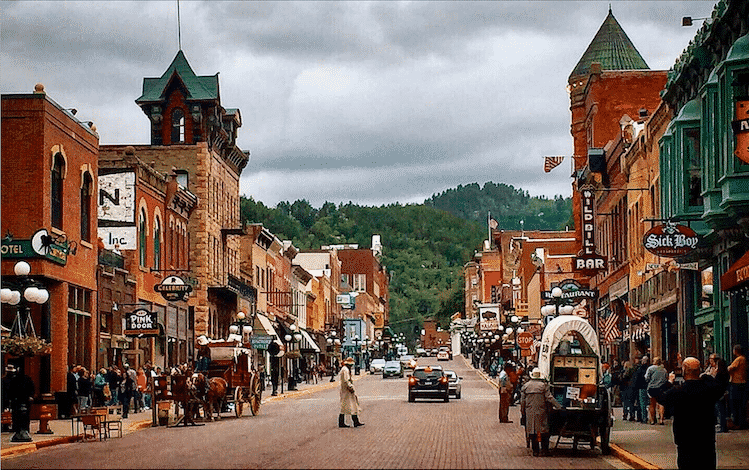
Deadwood’s Main Street hasn’t changed much since 1876 save for the brick paving and the fact that wooden sidewalks now are concrete.
By Rich Grant
“Wild Bill” Hickok, of Dakota’s most boisterous boomtown, was such a romantic figure that it is hard to believe he really existed. Of course, through dime novels, movies, HBO, television shows and merchandising for 155 years, his image has become a caricature of the real thing.
Look back at what contemporaries wrote about him, and you can understand why he became so famous as the first gunfighter – the “Prince of Pistoleers” – and the prototype for almost every Western hero.
Wild Bill Hickok
Here’s how a member of a wagon train described Wild Bill in 1865 as he rode up to bring the news that Lee had surrendered and the Civil War was over. “He was a striking figure as I noticed him, a large broad-brimmed hat on his head, long drooping mustache, long flowing hair that fell about his shoulders, a brace of ivory-handled revolvers strapped to his waist, and an extra pair of holsters that fitted about the horn of his saddle where he could reach them instantly.”
Libbie Custer (yes, the wife of that Custer) was a big admirer (and possible lover). She described Wild Bill, writing: “Physically, he was a delight to look upon. Tall, lithe and free in every motion, he rode and walked as if every muscle was perfection, and the careless swing of his body as he moved seemed perfectly in keeping with the man…He carried two pistols.
He wore top boots, riding breeches and a dark blue flannel shirt, with scarlet set in front. A loose neck handkerchief left his fine firm throat free and the frank, manly expression of his fearless eyes and his courteous manner gave one confidence in his word and in his undaunted courage.”
It was that Wild Bill who served as a marshal in some of the wildest cattle towns of the West. He had only to walk into a saloon if trouble was developing, and it vanished. One look at his two ivory-handled Navy Colt revolvers tucked into a red sash, the grips facing outward in a fashion he believed – and had proved – gave him a split-second advantage in a reverse quick draw, and whoever was causing trouble had second thoughts.
He was a killer, no doubt. Historians say he killed seven men. Wild Bill claimed a hundred. Between the Civil War and serving as a scout in the Indian wars, who knows?
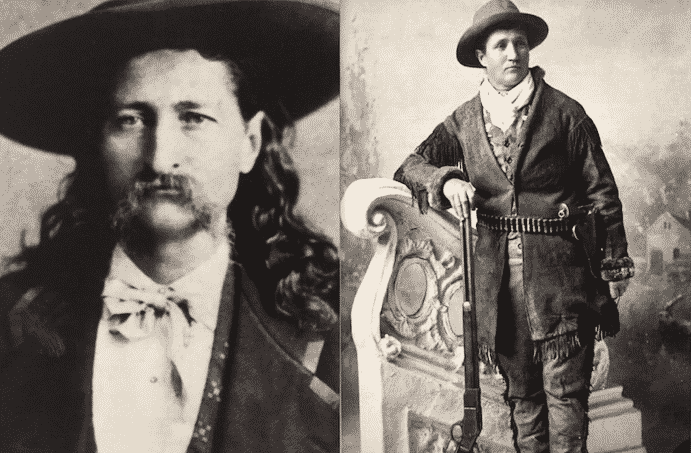
Historical portraits of Wild Bill Hickok and Calamity Jane as they appeared while living in Deadwood
Calamity Jane
Ironically, it is in Deadwood, South Dakota, where Wild Bill is still remembered the most. He’s buried there, and the local tourist bureau says there are more than 70 photos, murals, paintings and signs with images of Wild Bill at saloons, restaurants and gift shops around town. They encourage you to take and post selfies with them tagged #WildBillMe. The more you take, the bigger prizes you can win.
It’s ironic that Wild Bill is so famous here because he was only in Deadwood for two weeks and never did anything but play cards and get murdered. He was shot in the back of the head in a poker game, his cards sprawled on the table next to his body: two black aces and two black eights, forever being remembered as “the dead man’s hand.”
Now Calamity Jane, almost always linked most with Wild Bill, is a different story. She also was real and lived in Deadwood. In this case, if you mean by “real,” the real Calamity Jane was a cantankerous, foul-mouthed, masculine-looking, part-time prostitute, stagecoach driver, drunk, and all-around troublesome character. One look at the famous photo of her tells volumes.
Certainly, she and Wild Bill knew each other and had both been in some of the most dangerous towns of the West like Abilene and Hays City at the same time. They arrived together in Deadwood in the same wagon train from Cheyenne. But it’s doubtful they were ever lovers.
Wild Bill had just married a famous circus trapeze and high-wire artist, Agnes Lake, and went straight from their honeymoon to Deadwood to make his fortune. What is known for certain is that when Calamity Jane was dying, she said, “Bury me next to Wild Bill.” They did, perhaps as a joke, but the two are now side-by-side and a must-see visit.
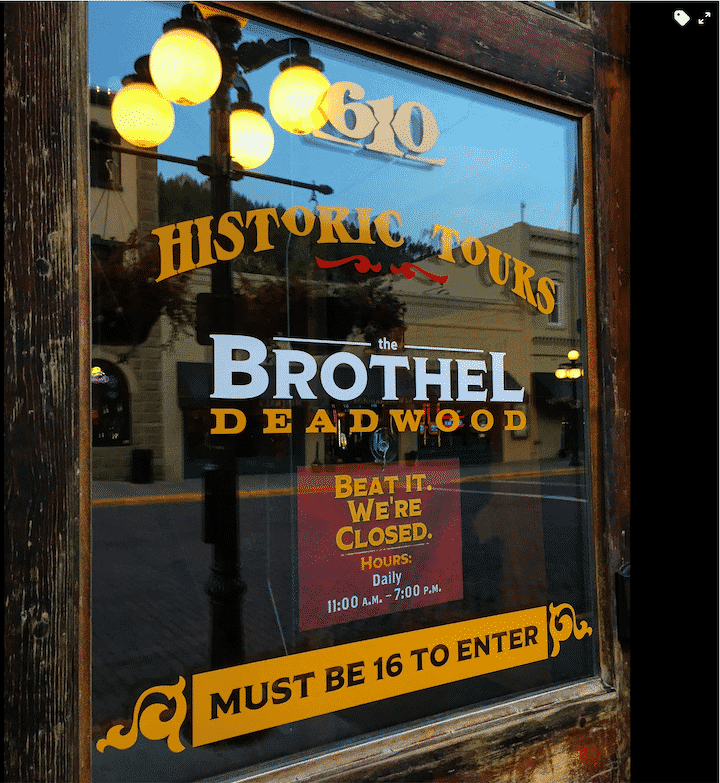
Pam’s Purple Door, a real brothel that closed in 1980, is now the entrance to The Brothel Deadwood museum.
So what can you find out about these marvelous real-life characters in Deadwood, South Dakota? Everything! Deadwood is wild, unique, possibly the best “Old West” town in the nation, a hoot of fun with bars and gambling. This is a town that is proud of the fact that the last brothel here closed in 1980 and you can certainly learn a lot about Wild Bill, Calamity Jane, Old West prostitutes, gold mining, stagecoach travel, shootouts and more.
The Adams Museum
This is the story of Deadwood, which for fans of the HBO series Deadwood, is a must. It’s also a good place to learn the early story of Wild Bill Hickok. Born in 1837, he served as a scout and maybe a spy for the Union during the Civil War. After the war, he was a teamster driver on the Overland Stage and may have killed a man in a shootout at Rock Creek Station. But as The Champion newspaper of Atchison, Kansas was later to describe him, “He was simply a desperado and dozens like him can be found.”
And then something remarkable happened.
On July 21, 1865, in Springfield, Missouri, Wild Bill got into an argument with a gambler named Dick Tutt, to whom he owed some money. Tutt took Wild Bill’s watch as security. Bill told him, “Don’t be flaunting that watch around town.” Tutt bragged to everyone that he had Wild Bill’s watch and would wear it in the town square. Wild Bill said, “Tutt shouldn’t pack that watch across the square unless dead men can walk.”
They finally met in the center of Springfield. Both pulled guns and Tutt’s shot missed. Wild Bill’s shot went straight through Tutt’s heart. At a distance of 80 yards, it was an incredible feat of marksmanship. A journalist in town wrote about it for Harper’s New Monthly Magazine and Wild Bill became a national sensation. This first standup gunfight, almost unlike any other to take place in the Old West, became the prototype for pulp fiction and Western movies and was re-created in novels and movies a thousand times.
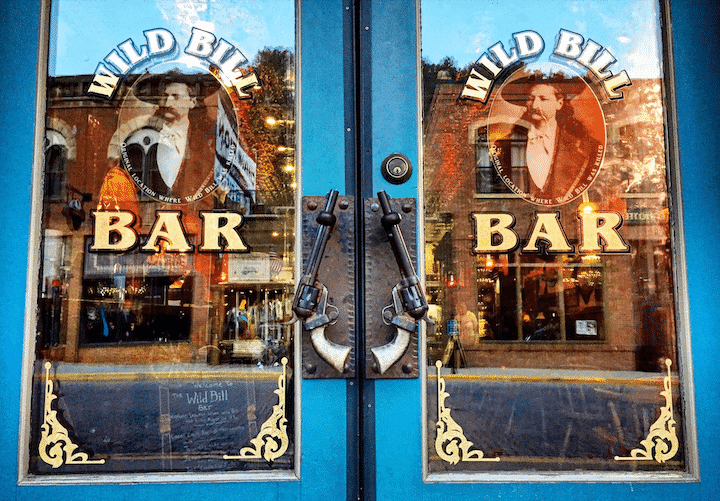
This is the bar on the site where Wild Bill was killed, but don’t miss Saloon Number 10 across the street
Standing at the spot in the modern downtown Springfield where the gunfight took place, there’s not much to see today except historic markers where both men stood. The spot where Dick Tutt stood shows his heart and what a small target that would have been. But stand in the Adams Museum in Deadwood and Wild Bill springs back to life.
Hickok went on to be town marshal in Hays City and Abilene, Kansas, bringing law and order to the wild cattle towns while killing several men in gunfights, becoming the most famous lawman of the West in the process. But a shootout in Abilene in 1871 was to be his ruin. On a dark night, while gunning down a troublemaker in a fair fight, Bill saw something out of the corner of his eye and blasted his two pistols. He accidentally shot and killed his deputy and friend, Mike Williams. Wild Bill was never the same. He gave up being a lawman, took to drinking, gambling and of all things, acting. Amazingly, Wild Bill Hickok and Buffalo Bill Cody met early in the West as young men and became lifelong friends. Buffalo Bill was a born promoter and showman and somehow talked Wild Bill into going east to New York to appear on the stage in a play called, “Scout of the Plains.”
A newspaper later wrote, “Wild Bill was a bad actor most anywhere, but he was an especially bad actor on the stage.” Wild Bill hated attention. He would show up drunk, forget lines, hide behind scenery on the stage, shoot out spotlights and intentionally fire his blank pistols beside the legs of actors playing Indians, causing them to yelp, howl and hop around the stage in pain when they were supposed to be dying.
Eventually, Buffalo Bill had to fire Wild Bill. Down on his luck, losing his eyesight, the former gunslinger went back West, married the love of his life, Agnes Lake, and went to the mining boomtown of Deadwood to trade on his fame and make his fortune.
While it might not be completely authentic, Saloon #10 is a great deal of fun. It’s an Old West saloon with sawdust on the floor, stuffed animal heads, guns and historic photos on the walls and servers dressed as saloon hall girls.
It was in a place called Nutall & Mann’s No. 10 Saloon that Wild Bill was murdered, and while the original location was across the street, the new Saloon #10 (billed as “the only museum in the world with a bar”) makes the most of its name. There are reenactments of the shooting three times a day.
Since it only takes a few seconds to walk up behind someone and shoot them, the saloon fills out the rest of the reenactment with an actor telling the history of Wild Bill.
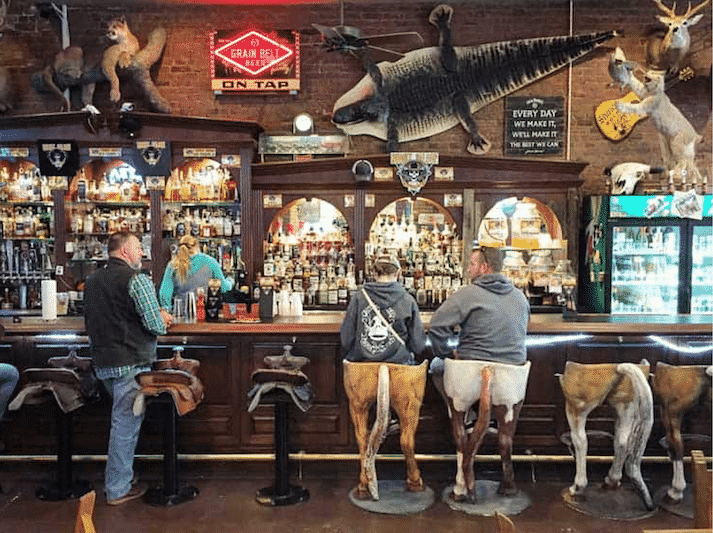
Deadwood has a lot of bars and all of them are fun. It’s easy to make a horse’s ass of yourself in this bar if you drink too much.
Bill never played cards with his back to the front door, fearing some enemy might shoot him. When he entered the No. 10 Saloon at noon on August 2, 1876, there was only one empty chair at a poker game, and that chair had its back to the bar and to a rear door. Bill asked the other players to change seats.
They laughed and refused, saying it was only noon and he had nothing to fear. A few hours later, he asked again to move chairs and was again refused. At 3 p.m., a drifter named Jack McCall walked in the front door, slid around by the bar, walked over to the rear door, and shot Wild Bill in the back of the head. Why? No one knows for sure. McCall was grabbed and held before a miner’s court where he testified Wild Bill had killed his brother. It was not true, but McCall was found innocent and let go.
Arrested later, McCall was tried by a real court, found guilty, hanged, and buried with the noose still around his neck. One theory behind the killing is that outlaws in the Wild West town feared Wild Bill was going to be made marshal and clean it up like he had Abilene, so they hired an assassin.
In the reenactment, after the murder, McCall runs out onto Main Street, where other reenacting gunslingers fire guns, chase, capture and haul him to the Masonic Temple, where the Trial of Jack McCall is staged. It’s just one of half dozen times during the day that reenacting gunslingers are out on Main Street firing guns.
After three days in Deadwood, you become so used to hearing gunfire that you don’t even look up when you hear angry words followed by explosions. Lots of people in town wear Old West cowboy hats and use bandanas as COVID face masks. My friend, Western history, Sid Wilson, and I did too, and we were often asked if we were part of the gunslinger show.
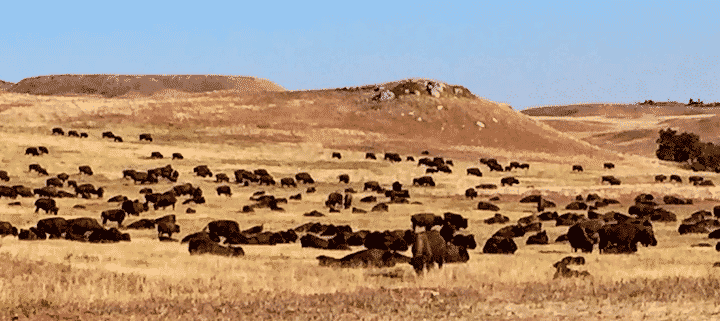
Gen. George Armstrong Custer died in Montana at the Little Bighorn, but he is memorialized in the Black Hills of South Dakota at the 71,000-acre Custer State Park. Located 30 minutes southwest of Rapid City near Mt. Rushmore, the park contains 1,500 bison plus hundreds of mule deer, bighorn sheep and mountain goats. Watch where you walk. Prairie Dog holes are everywhere.
It was the Custer Expedition of the Black Hills in 1874 that started the rumor of gold in the area, and the next year the glittering metal was discovered in Deadwood Gulch. By the time Wild Bill arrived in 1876, the overnight boomtown was filled with 5,000 prospectors, gamblers, con men, grifters, and prostitutes living in a tent and log city along mud-filled streets.
That town burned down in 1879 but was quickly rebuilt, starting a pattern for Deadwood of being continually destroyed by fire and flood and then quickly rebuilt in brick and stone. The result over 140 years is an architectural gem of a town. A self-guided walking tour leads to 21 historic markers, but there are also guided walking tours, ghost tours, a historic brothel tour and tours where you ride an authentic stagecoach.
The most fascinating part of town is Upper Main Street. This was always called “The Badlands.” By one count in 1885, the Badlands was home to 13 saloons, three gun shops, a dance hall, three gambling houses, and an untold number of brothels up on the second stories. Today, pretty mannequins in corsets and camisoles peak through the curtains from the second story, just as they would have back in the day, only now they are part of a museum.
Deadwood has done an amazing job of historic preservation. In 1989, they became the third place in America to legalize gambling (after Las Vegas and Atlantic City). But unlike Central City, Colorado, and other towns with gambling, Deadwood did it right. The street front remained historic with colorful “Old West” style signs. Four out of five storefronts lead to souvenir shops, bookstores, Western wear shops, restaurants and saloons. There are only a few out-and-out casinos in the historic district.
Though some of the bars and restaurants have slot machines, they are an afterthought in the back of the room, not cluttering it and filling the place with hideous slot machine noises. Also, no one can miss the famous purple door with a glass window emblazed with the word, “Brothel.”
This amazing new museum opened on August 1, 2020, and tells the 104-year history of prostitution in Deadwood – in an actual former brothel. You enter through a single door, climb a long flight of narrow stairs and come into the elegantly decorated parlor of what was known as The Shasta Rooms.
The first thing you learn on tours (presented every hour exactly on the hour, reservations recommended) is that the museum in no way endorses – or condemns – the sex trade. It is just historical preservation of what was an important part of life in the West in male-dominated railroad towns, mining towns, and military outposts.
Most of the emphasis is on the women who entered what was called “the Sisterhood.” In the frontier atmosphere of the West, where men greatly outnumbered women, some of these “ladies of the evening” found themselves without marriage, abandoned, widowed, in abusive relationships or even starving.
They entered a profession completely devoid of the romance sometimes attached to it in Western movies – a world where drugs and alcoholism, unwanted pregnancy, legal troubles, venereal disease, social ostracization and threats of physical violence were common.
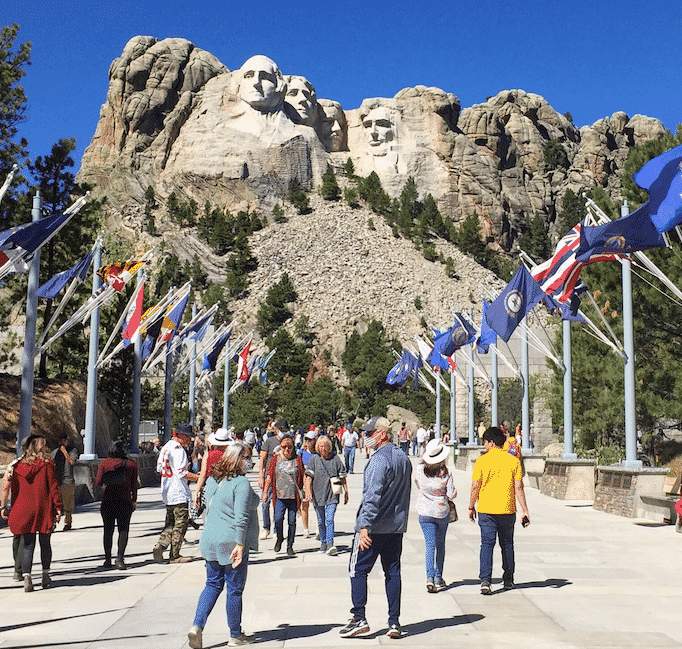
Mt. Rushmore is impressive, especially on warm summer nights when there is a sound and light show that covers the history of the four presidents depicted and the 14 years of work it took sculptor Gutzon Borglun to complete the granite monument. For some Americans the Mt. Rushmore National Memorial is controversial since it sits on land taken from the Lakota Sioux. In 1980, the Supreme Court ruled the U.S. government acquired the land illegally. A compensation trust now worth over $1 billion was set aside for the Sioux. That money has never been collected.
As in any profession, some sporting women did very well, making money, drinking fine wines, and finding rich husbands. Most had a different life, many of them committing suicide as they grew older and worked their way down the hierarchy from a parlor house to a common brothel to a low-end brothel and finally the end of the line, a crib house, a literal bed in a shack where these “daughters of joy” would entertain 30 to 40 men a night. Even lower were the streetwalkers, many of them homeless alcoholics, working the alleys for little more than food.
There were also saloon hall girls and dance hall girls, who sometimes crossed the line into prostitution, but for the most part, they were just entertainers dealing with hundreds of lonely men, who would wait in long lines and pay a quarter for just one dance.
The tour takes you to four rooms, each furnished as they would have been at different times in the brothel’s history, from early mining days right up into the 1980s, when there were still four brothels in Deadwood that were eventually closed by federal agents.
Deadwood was home to some of the most famous madams in history – Poker Alice, Dora Dufran, and Madame Moustache. Though Calamity Jane would rewrite her story in later years, she actually arrived in Deadwood in 1876 as a prostitute, part of a group of “soiled doves” that included Big Dollie, Dirty Emma, Smoothbore and Sizzling Kate.
The ladies attached themselves to Wild Bill Hickok’s wagon train for the journey from Cheyenne to Deadwood through Indian country. It must have been quite a day in Deadwood when the celebrated Wild Bill brought his wagon train of prospectors and fancy-dressed prairie nymphs into the mining camp.
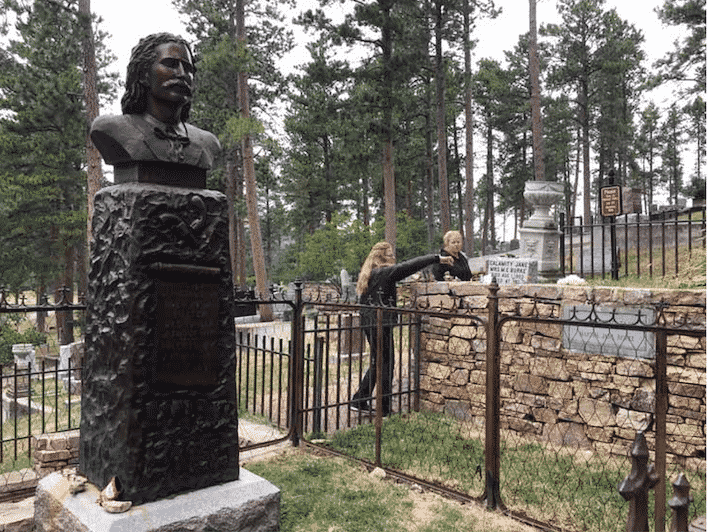
Buried side by side on a bluff above Deadwood, Wild Bill and Calamity are united in death as in life. The proximity no doubt pleases Calamity; Bill is probably perplexed.
The Black Hills Boothill – Mt. Moriah Cemetery
Wild Bill and Calamity are buried side by side in a beautiful grove of pine trees, high on a mountain above Deadwood. It’s a wonderful spot, but don’t try to walk there from town – the hill is very steep, and you can take a trolley for $1. Still higher up the mountain is the grave of Deadwood’s first sheriff, Seth Bullock, made famous in the HBO series “Deadwood.”
Bill’s first monument here was torn apart by souvenir hunters, and the new one is safely protected by an iron fence with tourists taking turns to pose for selfies or leave tribute items behind on the grave (a lot of cigars and playing cards were on the grave on the day we visited). Calamity Jane’s grave is much simpler, but her life was more complicated. Born as Martha Canary, she was an orphan by the time she was ten and grew up parentless in a wild frontier, working as a dance-hall girl, waitress, laundress and prostitute.
She took to wearing men’s clothes and was engaged as a stage driver, bullwhacker and teamster, chewing tobacco, swearing and hanging out in saloons. Such a colorful character became the subject of dime novels and books and Buffalo Bill Cody took her on as part of his Wild West Show. But any fame she achieved was soon undone by her alcoholism and troublesome nature. In Deadwood, she became a public hero when she worked with the sick during a smallpox epidemic without any thought to her own safety.
Whatever they thought of each other in real life, the bodies and legends of Wild Bill and Calamity Jane are now at peace under the pines.
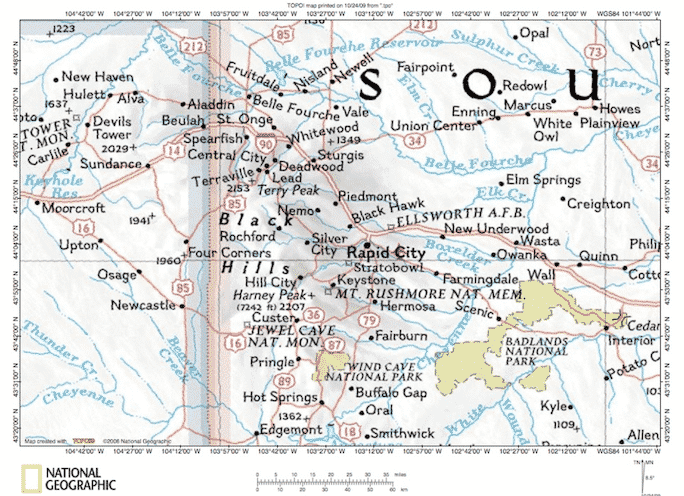
The Rapid City, South Dakota area includes Mt. Rushmore and Deadwood.
If You Visit Deadwood:
There’s so much more to do in Deadwood. The Days of ’76 Museum is another great western history attraction. There are gold mine tours, and the nearby town of Lead (pronounced so it rhymes with ‘seed’) has more old saloons, mines, and an interesting free museum about the Homestake Mine, which, until it closed in 2002, was the largest and deepest gold mine in the United States. Today, it is a scientific research center. And of course, Mount Rushmore and all its attractions are less than an hour away.
There are shuttles for $1 that travel to outlying hotels, but it’s the most fun to stay in downtown Deadwood within walking distance of the historic district, where all the fun and activity takes place.
Visits to Deadwood, Mt. Rushmore, the Black Hills and Dakota’s Badlands usually begin in Rapid City, where the airport has connections to most Midwest hubs. From Rapid, Deadwood is 41 miles (66 km) to the north. Mt. Rushmore is 24 miles (39 km) to the southwest. The highway to Deadwood runs through Sturgis, the reunion point for thousands of bikers every summer.
Denver writer Rich Grant, who took all the photographs for this story, is a member of the Society of American Travel Writers and the North American Travel Journalists Association. He is the co-author, with Irene Rawlings, of “100 Things to Do in Denver Before You Die,” published by Reedy Press in 2016.

